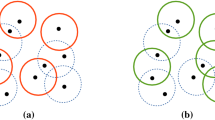Abstract
In this paper we define the exact k-coverage problem, and study it for the special cases of intervals and circular-arcs. Given a set system consisting of a ground set of n points with integer demands \(\{d_0,\dots ,d_{n-1}\}\) and integer rewards, subsets of points, and an integer k, select up to k subsets such that the sum of rewards of the covered points is maximized, where point i is covered if exactly \(d_i\) subsets containing it are selected. Here we study this problem and some related optimization problems. We prove that the exact k-coverage problem with unbounded demands is NP-hard even for intervals on the real line and unit rewards. Our NP-hardness proof uses instances where some of the natural parameters of the problem are unbounded (each of these parameters is linear in the number of points). We show that this property is essential, as if we restrict (at least) one of these parameters to be a constant, then the problem is polynomial time solvable. Our polynomial time algorithms are given for various generalizations of the problem (in the setting where one of the parameters is a constant).
Similar content being viewed by others
Notes
\(l\le u\) if and only if \(l_i\le u_i\) for every \(1\le i\le m\)
References
Ageev AA, Sviridenko MI (1999) Approximation algorithms for maximum coverage and max cut with given sizes of parts. In: Proceedings of IPCO, pp 17–30
Cohen R, Gonen M (2013) On interval and circular-arc covering problems, unpublished manuscript
Cornuejols G, Nemhauser GL, Wolsey LA (1980) Worst-case and probabilistic analysis of algorithms for a location problem. Oper Res 28:847–858
Demaine ED, Feige U, Hajiaghayi M, Salavatipour MR (2008) Combination can be hard: approximability of the unique coverage problem. SIAM J Comput 38(4):1464–1483
Erlebach T, van Leeuwen EJ (2008) Approximating geometric coverage problems. In: Proceedings of the 19th annual ACM-SIAM symposium on discrete algorithms, (SODA’08), pp 1267–1276
Feige U (1998) A threshold of ln n for approximating set cover. J ACM 45(4):634–652
Garey MR, Johnson D (1978) Computers and intractability: A guide to the Theory of NP-Completeness. Freeman, Bedford
Hochbaum DS, Levin A (2006) Optimizing over consecutive 1’s and circular 1’s constraints. SIAM J Optim 17(2):311–330
Ito T, Nakano S-I, Okamoto Y, Otachi Y, Uehara R, Uno T, Uno Y (2012) A polynomial-time approximation scheme for the geometric unique coverage problem on unit squares. Algorithm Theory SWAT 2012:24–35
Ito T, Nakano S-I, Okamoto Y, Otachi Y, Uehara R, Uno T, Uno Y (2014) A 4.31-approximation for the geometric unique coverage problem on unit disks. Theor Comput Sci 544:14–31
Lee J (2004) A first course in combinatorial optimization. Cambridge University Press, Cambridge
Matiyasevich Y (1993) Hilbert’s tenth problem. MIT Press, Cambridge
Misra N, Moser H, Raman V, Saurabh S, Sikdar S (2013) The parameterized complexity of unique coverage and its variants. Algorithmica 65(3):517–544
Misra N, Raman V, Saurabh S, Sikdar S (2009) The budgeted unique coverage problem and color-coding. In: Computer science-theory and applications, pp 310–321
Moser H, Raman V, Sikdar S (2007) The parameterized complexity of the unique coverage problem. In: Algorithms and computation, pp 621–631
Onn S (2010) Nonlinear discrete optimization., Zurich lectures in advanced mathematicsEuropean Mathematical Society, Zurich
Onn S, Rothblum U (2004) Convex combinatorial optimization. Discret Comput Geom 32:549–566
Papadimitriou CH (1994) Computational complexity. Addison-Wesley, Boston
Author information
Authors and Affiliations
Corresponding author
Rights and permissions
About this article
Cite this article
Cohen, R., Gonen, M., Levin, A. et al. On nonlinear multi-covering problems. J Comb Optim 33, 645–659 (2017). https://doi.org/10.1007/s10878-015-9985-4
Published:
Issue Date:
DOI: https://doi.org/10.1007/s10878-015-9985-4




